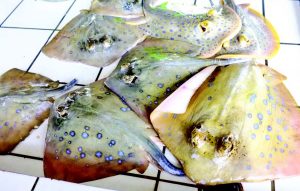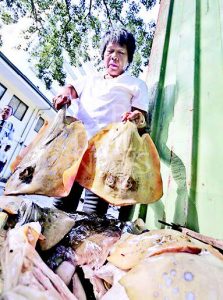As stewards of creation, man is tasked with keeping its fellow creatures safe. Unfortunately, despite the many laws protecting animal life from extinction, illegal markets for endangered species abound.
Let’s find out what’s happening on the local front — and what we can do to help.
1. Know what you’re buying and find out where it’s sourced
Research on the fish you’d like to buy, and make sure it isn’t an endangered species. Ask the vendor where their fish came from, or ask people familiar with the market you frequent about your vendor’s source of fish.

Markets in Mandaue City, Cebu
In December 2015, the Cebu Provincial Anti-Illegal Fishing Task Force (CPAIFTF) confiscated 49 stingrays worth PhP 5,500 during a surprise inspection of a market in Mandaue City, according to an article Victor Anthony Silva and Nestle Semilla for Cebu Daily News.
In March 2016, the CPAIFTF again confiscated 41 stingrays worth Php4,400 while inspecting the Mandaue City Public Market, reported Sevilla in the same publication.
In both instances, the stingray vendors admitted they bought their stock from the Pasil Fish Market.
Pasil Fish Market, Cebu
In August 2016, authorities from the CPAIFTF found and consequently buried a flat shark stingray, locally known as “pagi” (Manta birostris), that was being transported to the Pasil Fish Market in Cebu City, reported The Freeman. In July 2017, at least 60 stingrays valued at around Php 12,000 were seized from the same market, according to a 2017 news article in Sun Star Philippines. The Provincial Fisheries and Aquatic Resources Ordinance of Cebu (Provincial Ordinance 2015-21) is meant to prohibit the selling and transporting of sharks and rays. Stingrays have since been added to its list of protected marine species, according to a 2016 report published in the same paper.

Sen. Juan Miguel Zubiri also proposed the Sharks and Rays Conservation Act or Senate Bill 1245 in 2016, aiming to ban the “catching, sale, purchase, possession, transportation, and exportation of all sharks and rays or any part thereof” throughout the Philippines, as reported by Paolo Romero for Philippine Star in 2017.
2. If you suspect or are aware of any vendor selling endangered fish, act fast and report them to the BFAR, your local government unit, or the Department of Environment and Natural Resources
Like Cebu, your city might have a local ordinance in place prohibiting the sale or transport of endangered fish. Filipinos are also bound to the Philippine Fisheries Code of 1998 or Republic Act No. 8550 –“an Act providing for the development, management, and conservation of fisheries and aquatic resources”– which protects rare, threatened, and endangered species.
Markets along the Abra and Cagayan Rivers
The Abra River and Cagayan River are home to the most expensive fish in the Philippines: the Ludong (Cestraeus plicatilis). The Ludong, also known as the Lobed River Mullet or President’s Fish, can cost as much as PhP 10,000 in markets.
In an effort to conserve the species, the Bureau of Fisheries and Aquatic Resources (BFAR) bans the use of nets to catch the Ludong and enforces a “closed season” from October to January to allow the species to spawn. The bureau’s plan to conserve the Ludong was allotted a funding of PhP 26M earlier this year, reported Leander Domingo in a 2018 article for The Manila Times.
Estancia, Iloilo
In August 2014, police seized a truckload of helmet and smooth top shells worth PhP 2.5M in Iloilo. The truck had reportedly come from Estancia, according to a report by Joel Locsin published in GMA News Online.

In December 2017, three traders were caught selling dried seahorse, seadragons, and nautilus shells — all worth PhP 1.6M. The endangered marine species were also reportedly sourced from the municipal waters of Estancia, according to Cindy Ferrer of Philippine News Agency. The aforementioned incidents did not occur within Estancia, but originated from its waters.
Based on a 2016 report by Apple Grace Danuco for SunStar Philippines, many local and international markets are said to source their stock of endangered fish from Estancia, including the Pasil Fish Market in Cebu.
3. Better yet, don’t buy fish, period
The main cause of fish loss in the Philippines is overfishing, based on a 2017 report by Stephanie Tumampos for Business Mirror.

Prevent fish loss and avoid the risk of accidentally buying endangered fish altogether by not consuming fish at all. [Aside from being a top driver for fishery collapse, fish consumption also carries the risk of heavy metal poisoning. Besides, one can source omega-3 fatty acids from plant sources, sans the threat to endangered marine life. -Ed.]
Dasmarinas City Central Market, Cavite
According to a 2008 article by Perseus Echeminada, the Tawilis (Sardinella Tawilis), once the most dominant fishery of Taal Lake, is now considered endangered due to the overfishing of the species and the introduction of the invasive Tilapia.
The Tawilis is a freshwater sardine found only in Taal Lake in Batangas, and is reportedly sold in the Dasmarinas City Central Market in Cavite. According to Jonathan Mayuga in a 2016 Business Mirror article, the lake is considered part of the Taal Volcano Protected Landscape, a priority conservation area under the National Integrated Protected Areas Act.
This appeared in Animal Scene magazine’s October 2018 issue. t






